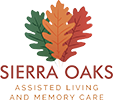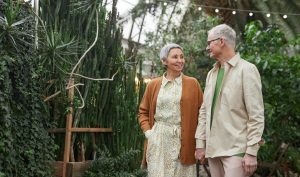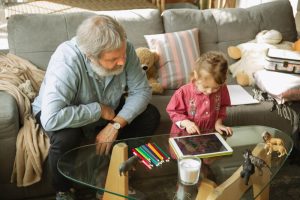When it comes to dementia, two outstanding types frequently mentioned are Lewy Body Dementia (LBD) and Frontotemporal Dementia (FTD). Understanding these differences may be vital in managing sicknesses and offering appropriate care. LBD is characterized by using unusual protein deposits known as Lewy bodies inside the mind, leading to signs and symptoms like fluctuating cognition, visible hallucinations, and motor problems.
On the opposite hand, FTD often influences the brain’s frontal and temporal lobes, causing vast modifications in persona, conduct, and language. This blog will explore the symptoms, age groups affected, development, and other vital factors of Lewy Body Dementia or Frontotemporal Dementia to assist in deciding which might be considered worse in distinct contexts. By inspecting those elements, we propose to offer a clearer understanding of each disorder and help families and caregivers make informed choices regarding care and control.
What is Frontotemporal Dementia (FTD)?
FTD is a collection of disorders that primarily affect the frontal and temporal lobes of the brain. These regions are chargeable for personality, conduct, and language.
Symptoms of FTD
- Behavioral Changes: People with FTD often exhibit extensive changes in conduct and persona. They may additionally become socially irrelevant, impulsive, or emotionally indifferent.
- Language Problems: FTD can cause difficulties in talking, understanding language, and using the correct words.
- Movement Issues: In a few cases, FTD can result in motion issues, including stiffness, stability problems, and trouble on the foot.
Age of Onset
FTD typically affects individuals between the ages of 40 and 65. This early onset will have profound impacts on families and careers, as it affects individuals who are often in their top-running years.
Progression and Life Expectancy
Once diagnosed, FTD patients’ median survival time is three to 7 years. The disease progresses at various costs; however, it usually results in extreme incapacity and dependence.
What is Lewy Body Dementia (LBD)?
LBD is a form of innovative dementia that affects thinking, motion, behavior, and temper. It is characterized by the presence of odd protein deposits known as Lewy bodies in the brain.
Symptoms of LBD
- Cognitive Fluctuations: LBD sufferers frequently revel in large variations in attention and application that can trade swiftly from hour to hour or day to day.
- Visual Hallucinations: Hallucinations are a hallmark of LBD and are often distinct and shiny.
- Movement Disorders: Similar to Parkinson’s sickness, LBD can cause signs like muscle tension, tremors, and a shuffling stroll.
- Non-Cognitive Symptoms: These consist of sleep disturbances, depression, and autonomic anxious gadget disorder, leading to issues like blood pressure instability.
Age of Onset
LBD broadly influences older adults, with the bulk of instances recognized in humans sixty-five and older. This later onset can affect exceptional lifestyles throughout senior years.
Progression and Life Expectancy
LBD tends to progress more slowly than FTD, with an existence expectancy from 5 to 10 years after analysis. However, the fluctuation in signs and symptoms can be specifically challenging for caregivers and medical experts to manipulate.
Comparing the Two: FTD vs. LBD
Lewy Body Dementia or Frontotemporal Dementia are devastating diseases that impact the mind, but they’ve beautiful characteristics.
Behavioral and Cognitive Symptoms
- FTD: This disease is characterized by dramatic adjustments in persona and behavior, often resulting in socially inappropriate movements and emotional withdrawal. Language difficulties, consisting of speaking and knowledge speech, are also commonplace.
- LBD: Individuals with LBD experience cognitive fluctuations, vibrantly visible hallucinations, and movement issues, much like Parkinson’s disease. They may suffer from non-cognitive signs like sleep issues and depression.
Age of Onset
- FTD typically influences people between the ages of 40 and 65, disrupting their prime working years and family lifestyles.
- LBD generally affects older adults, usually those sixty-five and over, impacting their lavish lifestyles throughout their senior years.
Progression and Life Expectancy
- FTD: The median survival time is between three to 7 years, with rapid progression leading to severe disability.
- LBD: Has a slower progression with a life expectancy of five to ten years. However, the extensive fluctuations in signs and symptoms may be very hard to manage.
Challenges in Diagnosis
Diagnosing Lewy Body Dementia or Frontotemporal Dementia can be extremely challenging because of their overlapping signs with other sorts of dementia and neurological problems. This makes accurate diagnosis essential yet complex.
For FTD, numerous diagnostic equipment are hired:
- Neuroimaging: MRI and CT scans can screen atrophy inside the frontal and temporal lobes, which might be indicative of FTD.
- Genetic: Testing can detect hereditary mutations related to FTD, imparting insights into the ailment’s familial patterns.
- Clinical Evaluation: Healthcare vendors determine behavioral adjustments and language problems, which might be hallmark signs and symptoms of FTD.
Proven ways to Diagnose LBD
- Neuroimaging: Advanced imaging techniques can locate Lewy body deposits within the brain that are functions of LBD.
- Cognitive Tests: These tests detect fluctuations in interest and the presence of visible hallucinations, which are common in LBD.
- Clinical Evaluation: Exact patient records and thorough symptom evaluation are essential in distinguishing LBD from dementia.
Both Lewy Body Dementia and Frontotemporal Dementia require careful assessment and the use of an aggregate of these diagnostic tools to ensure correct prognosis and suitable management of the conditions.
Treatment and Management for FTD vs. LBD
There is presently no remedy for either Frontotemporal Dementia (FTD) or Lewy Body Dementia (LBD), but treatments can help manipulate symptoms and lifestyles.
Treatment for FTD
- Medications: Antidepressants and antipsychotic medicinal drugs can assist in managing behavioral signs along with mood swings, aggression, and agitation.
- Therapies: Various healing procedures can help people with FTD. Speech and language therapy can help with communication difficulties. Occupational therapy can help sufferers preserve independence in everyday sports. Physical therapy can help preserve mobility and normal physical health.
Treatment for LBD
- Medications: Cholinesterase inhibitors are often prescribed to assist with cognitive signs along with memory loss and confusion. Medications used to deal with Parkinson’s ailment can help manage movement issues like tremors and stiffness.
- Therapies: Physical therapy can enhance strength and stability, decreasing the danger of falls. Occupational remedies can help with daily tasks and improve the affected person’s exceptional life. Additionally, techniques to control sleep issues and hallucinations are essential, as those symptoms are common in LBD.
While these treatments are not therapy for FTD or LBD, they could support the well-being of those stricken by those conditions.
Caregiver Support
Both Lewy Body Dementia and Frontotemporal Dementia regions have gigantic stress on caregivers, requiring extensive guidance and assets to manage the challenges.
Support for FTD Caregivers
- Behavioral Management: Caregivers can use specific strategies to deal with impulsivity and social inappropriateness often seen in FTD patients. These might include setting workouts, using distraction strategies, and imparting clear and simple commands.
- Communication Aids: Tools and strategies to help with language difficulties are vital. These can involve image forums, speech therapy, and activities that do not rely closely on verbal exchange.
- Support Groups: Connecting with others dealing with comparable challenges can provide emotional help and realistic advice. Support groups offer an area to proportion stories, research from others, and feel less remoted.
Support for LBD Caregivers
- Managing Fluctuations: Caregivers need techniques to deal with changes in attention and hallucinations, which can be not unusual in LBD patients. Keeping peaceful surroundings, using distraction techniques, and understanding while seeking scientific recommendations are essential.
- Movement Assistance: Helping with mobility and stopping falls is essential. This entails using mobility aids, maintaining a safe home environment, and engaging in physical therapy activities.
- Support Networks: LBD caregivers need to have access to assets and guide companies. These networks provide facts, emotional aid, and realistic recommendations for handling the unique, demanding situations of LBD.
Let’s Recap
Both Lewy Body Dementia and Frontotemporal Dementia are severe situations that require thorough care and support. Progress in research and treatment is crucial for boosting the quality of life for patients and their families.
Sierra Oaks Assisted Living, a most trusted and top-rated senior residing network in Redding, California, is committed to providing top-notch support. Located close to stunning Caldwell Park and the serene Sacramento River, we invite you to contact us to help your loved one live a happy, fulfilling life despite the challenge of dementia!





